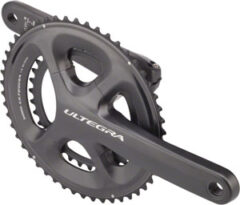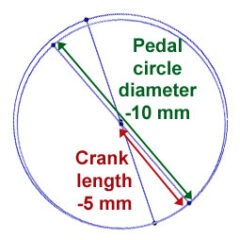The Problem
The length of cranks used on bicycles is important because:

- Over two-thirds of cyclists are using cranks that are longer than recommended.
- Using cranks that are too long can cause cycling discomfort and injuries, especially when riding longer distances, due to excessive articulation of the knee and hip at the top of the pedal stroke; using cranks that are too short is far less likely to cause problems.
- For various reasons (which could be the topic of another entire post), the length of cranks that are fitted on new bikes varies very little.
- Crank length should be proportional to leg length, just as saddle height and handlebar reach are proportional to other body dimensions.
Crank Length Recommendations
There are lots of recommendations and formulas for how to determine a cyclist’s “ideal” crank length, all of which are slightly different, but most lead to similar recommendations. I combined all of the information and further simplified things by only considering typical crank lengths and people’s heights to make 5 recommendations:

- For people shorter than 1.65 m (5’5″), cranks no longer than 160 mm are generally recommended, but these are not so easy to find (such people’s bikes probably came with 165 or 170 mm cranks).
- For people between 1.65 m & 1.72 m (5’5″ & 5’8″), 165 mm cranks are generally recommended (such people’s bikes probably came with 170 mm cranks).
- For people between 1.72 m & 1.78 m (5’8″ & 5’10”), 170 mm cranks are generally recommended (such people’s bikes probably came with 172.5 mm cranks).
- People between 1.78 m & 1.90 m (5’10” & 6’3″) are probably OK with the crank length that their bike came with (172.5 or 175 mm).
- People taller than 1.90 m (6’3″) could consider cranks that are 180 mm or longer, but these are not so easy to find (such people’s bikes probably came with 175 mm cranks). Fortunately, riding a crank that is shorter than recommended is unlikely to cause major problems.
Summary
Everyone up to about 1.78 m tall (5’10”) is probably riding cranks that are longer than recommended and this may be the cause of discomfort or injury because it can be just as important to optimize the amount of articulation in the joints at the top of the pedal stroke as it is at the bottom. People taller than 1.78 m (5’10”) probably have a reasonable crank length for them, but they may still benefit from trying something else, especially if they are having bike fit issues or are particularly tall.
The shorter somebody is, the bigger the difference is between the recommended crank length and the length that the person’s bike came with, so the more likely it is that his/her crank length will cause problems, especially when Riding Far.

The above recommendations are very general and will not work for everyone. People pedal differently, have different leg length to body height ratios and react to changes in their bike fit differently. A professional bike fitter can hopefully give advice that is tailored to a specific individual. Unfortunately, many bike fitters don’t appreciate the importance of crank length because they often assume that the bike brands know what they’re doing when selecting crank lengths for each frame size.
For people shorter than 1.65 m (5’5″), the recommendation given above is deliberately vague. This is because the differences between the conclusions of the various methodologies are greatest for this height range. Hopefully those people can find a bike fitter who properly understands how to fit shorter people and they may well have to look outside of the major component brands to find a crank of the appropriate length (see options below).
Discussion
To maintain the same leg extension at the bottom of the pedal stroke when switching to a shorter crank, the saddle should be raised by the same amount as the difference in the two crank lengths. It is then the difference in pedal height between the top and bottom of the pedal stroke that is important, which is twice the crank length.

Therefore, a 2.5 or 5 mm difference in crank length corresponds to a 5 or 10 mm difference in pedal circle diameter and the pedal height at the top of the circle. Most experienced cyclists would consider a 5 or 10 mm difference in saddle height measured to the bottom of the pedal stroke to be a significant change, so they should not dismiss a 2.5 or 5 mm difference in crank length as being any less important because that makes a 5 or 10 mm difference in the saddle height when measured to the top of the pedal stroke.
Even so, I admit that a 2.5 mm change in crank length is hard to notice. I therefore normally recommend that if someone is going to experiment with different crank lengths that they should change it by at least 5 mm to make it noticeable and worthwhile. It would be better if manufactures only produced cranks in 5 mm increments and offered a wider range of sizes.
Many people wrongly assume that longer cranks = more torque = more power. However, torque doesn’t equal power if cadence isn’t kept constant and because longer cranks tend to reduce cadence, research has shown that power tends to stay relatively constant across a much wider range of crank lengths than has been discussed here. Crank length should therefore be chosen based on comfort and injury prevention, not on power optimization.
I’m not trying to invent anything new here, my recommendations are simply a summary of advice that has been offered by researchers and professional bike fitters.
Take-Home Message

I hope that this article makes people think more about their crank length and to question whether the narrow range of crank lengths selected by bike manufacturers has resulted in them actually having the most appropriate crank length for them.
Many ultra-distance cyclists (of all heights) have told me stories about how fit problems that they had struggled with disappeared when they tried using shorter cranks and so reduced the amount of articulation in their joints. Personally, I’m 1.72 m tall and am so much happier now that I’m using 165 mm cranks instead of the mix of 170 and 172.5 mm cranks that came stock on my bikes.
Crank Availability
The 4 major road crankset brands, Shimano, SRAM, FSA/Vision and Campagnolo offer road cranks from 165 mm to 175 mm, with certain models going to 177.5 or 180 mm. Some smaller manufacturers offer a wider range of sizes, including Rotor, TA Spécialités and Lightning. For extra-short cranks, the Stonglight Impact Kid is offered in sizes from 130 to 155 mm, but unfortunately the square-taper bottom bracket won’t fit in many modern frames. Lennard Zinn is a specialist in extra-long cranks plus bikes with geometry adapted to them and he also makes extra-short cranks. Please let me know in the comments if I’m missing other good options.
Further Reading
Three years ago I made a much longer and more detailed blog post about crank length that didn’t include simple, specific recommendations like I’ve made here, but covered more of the research and theory.
If you want to delve deeper into the topic, please read some of the sources that I used when putting this post together:
YouTube videos:
Bike Fit Adviser on YouTube
Bike Fit Tuesdays by Francis Cade
How to measure your inseam
Global Cycling Network (GCN)
Articles:
Lennard Zinn
Sheldon Brown
CyclingTips
Kirby Palm
Myra VanInwegen
Table by Sugino
Bike Test Reviews
Bike Dynamics
What is your basis for recommending shorter cranks? I know this is a controversial subject, but the Kirby Palm method generally results in longer cranks than are typically fitted for a given leg length.
I hope I summarized my reasoning in the article quite well, but the 3 main reasons are the following:
1. The vast majority of methods for determining crank length suggest that most people would be better off with shorter cranks than are fitted as standard on new bikes, although I’m sure it’s possible to find exceptions as you have noted.
2. Many well-renowned bike fitters have said that using a crank that is too long risks creating discomfort, problems, and injuries due to the knee bending too much at the top of the pedal stroke. In contrast, I’ve never read anyone who said that using cranks that are shorter than ideal causes any major problems; even though it might not be ideal biomechanically, tall people using short cranks doesn’t seem to cause injuries. So, it’s much safer to have cranks that are too short than too long.
3. There is anecdotal evidence from discussions I’ve had with various experienced ultra-distance cyclists. Several have told me that they eliminated problems or discomfort after they started using shorter cranks. I’ve never heard of anyone reporting the opposite – that switching to a longer crank got rid of any specific issue – although some people do ‘prefer the feeling’ of a longer crank.
In addition, I don’t recommend that everyone should use a shorter crank. For certain people, it’s not needed or won’t solve the problem that they have. For people who are very tall, they are probably riding cranks that are proportionally very short compared to most average-height people, so very tall people may well benefit from trying some longer cranks and I state that in my recommendations above.
The most important point is that there should be a much stronger relationship between leg length and crank length, standard practice is to equip new bikes with a ridiculously narrow range of crank lengths. People therefore need some guidance as to what range of crank length is likely to be suitable for them rather than relying on the bike manufacturers to make that decision. The majority of research, theory and experience points to the fact that more often than not, most people will be better off using shorter cranks than their bike was delivered with, but there are lots of exceptions to this for lots of reasons.
Thank you Chris for this information which I was lucky enough to get from you a couple years ago — As you know, I was using the standard 170mm cranks that came with my bikes (I’m 1.7m), and was having pains in my knees – which prompted me to raise the saddle, and that helped relieve the knee-pain, but then I developed pain in my hips since the saddle was too high! Which prompted me to lower the saddle…. and so the cycle continued….. until you wisely suggested that I try 165mm cranks — and ever since I have had NO pain in my knees NOR my hips, and haven’t had to change my saddle height ever since.
Thank you for your wise advice!
Great summary, thank you!
I am 5ft 10” and have 172.5mm cranks. Would I benefit from 170mm cranks?
Why is crank length related to height and not to leg length?
In the simplified version presented in this article, I gave rules of thumb about how crank length can vary with height. Various more specific formulas have been proposed for how to determine an ideal crank length and most of these use leg inseam length (see my more detailed blog post on this topic). However, these formulas often give quite different answers, so that’s why I chose to break it down into some general rules of thumb based on height – the guidelines are quite general anyway, so the imprecision introduced by using height instead of inseam doesn’t change much. The main take-home message should be that varying crank length can often yield improvements in comfort, but it is generally overlooked by bike brands and bike fitters. Making a 2.5mm difference is often hard to notice – I don’t know why component manufacturers produce them in such small increments while offering such a narrow range, often a 5mm difference is necessary for it to be noticeable. I encourage experimentation to find out what works for you.
Interesting article you’re right crank length is important to height, otherwise you can exhaust yourself before you’ve been anywhere! I myself have a pair of 157mm crank arms on two different rides my first came with 175mm cranks they had to go I’m a serious short rider all 5,4 of me!
You say “Crank length should be proportional to leg length…” and then use a tape measure for total height rather than leg length. Weird!
I’m 1.73m and told my frame size should be anywhere from 53 to 56. I ride a 51 because my inseam is 75 cm, so am really built strange and have to ‘convert’ fit and length formulas all the time. Like yours.
I haven’t suggested any precise formula for determining crank length, I only give general guidelines, so using leg length instead of height still wouldn’t make my rough guidelines more precise. In addition, it’s largely about flexibility and other factors that aren’t related to leg length. My main point is that people (and bike fitter) should give more consideration to crank length and when possible experiment to see what works best.
In terms of variation in bike sizes, I’m about 1.72m and I ride bikes anywhere between 50 and 54 cm partly because the size labels are quite arbitrary and different brands use different methodologies. Therefore one shop who sells brand A might suggest a 53cm frame while another who sells brand B suggests a 56cm frame, and they could both be talking about extremely similar effective frame sizes. That’s why some brands have abandoned labeling frame sizes with artificial measurements and use S, M, L, etc. (which doesn’t solve the problem, but at least it doesn’t pretend to be so standardized as does using fake measurements).